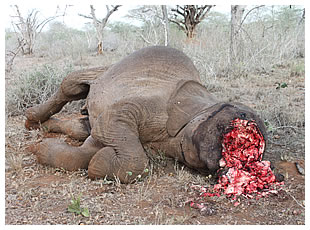There has been a catastrophic decline of elephant populations in Tanzania over the past decade, the country’s Minister for Natural Resources and Tourism, Lazaro Nyalandu, has disclosed. According to him, the latest estimates of elephant populations have seen numbers plummeting from an estimated 109,051 in 2009 to 43,330 in 2014. Government officials said that it was highly likely that the decline was caused by poaching for ivory.

“The government’s figures show Tanzania lost tens of thousands of elephants over the past decade,” said Steven Broad, TRAFFIC’s Executive Director. “It is incredible that poaching on such an industrial scale has not been identified and addressed before now.”
This news confirms concerns raised by TRAFFIC in 2013 in a report from the Elephant Trade Information System (ETIS), which pointed to a profound shift in ivory smuggling routes to Tanzania’s Indian Ocean ports of Dar es Salaam and Zanzibar as the principle exit points for vast quantities of ivory.
Latest information compiled by TRAFFIC from seizure records indicates that more ivory – at least 45 tonnes – has flowed from Tanzania to international markets in Asia than any other African country since 2009. Forensic analyses have confirmed that seizures made in Uganda and Kenya have also involved ivory originating from Tanzania.
A breakdown of elephant numbers across the country presented by Nyalandu showed some smaller elephant populations had increased significantly, notably the elephant population in the famed Serengeti, which rose from 3,068 to 6,087 animals. However, beyond the most heavily visited, northern circuit tourist locations, elephant numbers were significantly down.
Of particular concern is the Ruaha-Rungwa ecosystem, where an estimated 8,272 elephants were found in 2014, compared to 34,664 in 2009, according to government figures. Surprisingly, relatively few elephant carcases were spotted during surveys that would account for the decline and wildlife officials were at a loss to explain the discrepancy.
Nyalandu did announce a suite of measures to protect the country’s elephants, including recruitment of an additional 500 rangers this year in addition to the 500 extra already hired by the Ministry of Natural Resources and Tourism in 2014, better support for existing rangers and a doubling of ranger numbers in the key elephant stronghold of Ruaha-Rungwa, plus closer co-operation with neighbouring Zambia on anti-poaching measures.
Tanzania was already under pressure to address elephant poaching and illegal trade from its fellow members of the Convention on International Trade in Endangered Species of Wild Fauna and Flora (CITES). Along with a number of other African and Asia countries, Tanzania was required to develop an Ivory Trade Action Plan to guide its protection and enforcement efforts.
“While the measures announced this week by the Tanzania government are welcome, there is a real risk that it could be a case of too little too late for some elephant populations”, said Broad.
“Tanzania has been haemorrhaging ivory with Ruaha-Rungwa the apparent epicentre and nobody seems to have raised the alarm; it is clearly essential that the government establish exactly how this has been allowed to take place, while taking urgent and incisive action to bring the situation under control.”
